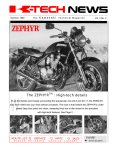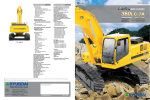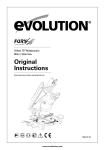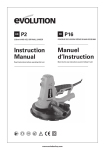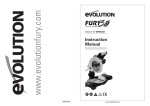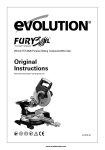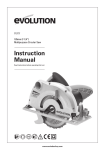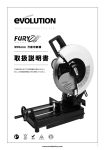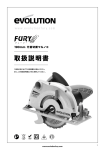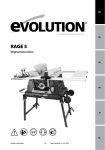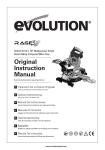Download Evolution FURY5 Instruction manual
Transcript
® 255mm TCT Multipurpose Table Saw Original Instructions Read instructions before operating this tool. www.evolutionfury.com TABLE OF CONTENTS GB Instruction Manual Read instructions before operating this tool. EC - Declaration of Conformity 04 Important Information 05 12 Month Limited Warranty 05 General Safety Rules 05 Safety Precautions for Table Saws 07 Symbols08 Additional Specific Safety Rules 08 Specification09 Machine Overview 11 Assembly12 Operation18 Maintenance22 Environmental Protection 24 Service Parts Lists 25 2 EC - DECLARATION OF CONFORMITY We, manufacturer and importer Evolution Power Tools Ltd. Venture One Sheffield S20 3FR Declare that the product Part numbers: FURY 52551, FURY 52552, FURY 52552EU Evolution: FURY TABLE SAW – 255mm Complies with the essential requirements of the following European Directives: 2006/42/EC – Machine Directive 2006/95/EC – Low Voltage Directive 2004/108/EC – EMC Directive 2002/95/EC – Restriction of the use of Certain Hazardous Substances in Electrical and Electric equipment. The following standards have been applied: EN 61029-1:2009 EN 61029-2-1:2010 EN 55014-1:2006 EN 55014-2:1997+A1 EN 61000-3-2:2006 EN 61000-3-3:1995+A1+A2 Authorised by Mr Matthew J Gavins Managing Director 1st June 2010 All documentation is held on file at the above address and is available, on request for review. 3 www.evolutionfury.com IMPORTANT Please read these operating and safety instructions carefully and completely. For your own safety, before using this equipment check that the voltage is correct and that all handles and parts are firmly secured. If you are uncertain about any aspect of using this equipment, please contact our Technical helpline. Helpline. Technical Helpline UK Technical Helpline USA 0870 609 2297 1-866-EVO-TOOL EVOLUTION 255mm FURY 5 TABLE SAW Congratulations on your purchase of an Evolution Power Tool 10˝ Fury Table Saw. Please complete your product registration on line to validate your machine’s warranty period and ensure prompt service if needed. We sincerely thank you for selecting a product from Evolution Power Tools. 12 MONTH LIMITED WARRANTY Evolution Power Tools reserves the right to make improvements and modifications to design without prior notice. Evolution Power Tools will, within twelve (12) months from the original date of purchase, repair or replace any goods found to be defective in materials or workmanship. This warranty is void if the tool being returned has been used to cut materials beyond the recommendations in the Instruction Manual or if the saw has been damaged by accident, neglect, or improper service. This warranty does not apply to machines and / or components which have been altered, changed, or modified in any way, or subjected to use beyond recommended capacities and specifications. Electrical components are subject to respective manufacturers’ warranties. All goods returned defective shall be returned prepaid freight to Evolution Power Tools. Evolution Power Tools reserves the right to optionally repair or replace it with the same or equivalent item. There is no warranty – written or verbal – for saw blades. In no event shall Evolution Power Tools be liable for loss or damage resulting directly or indirectly from the use of our merchandise or from any other cause. Evolution Power Tools is not liable for any costs incurred on such goods or consequential damages. No officer, employee or agent of Evolution Power Tools is authorised to make oral representations of fitness or to waive any of the foregoing terms of sale and none shall be binding on Evolution Power Tools. Questions relating to this limited warranty should be directed to the company’s head office, or call the appropriate Helpline number. IMPORTANT SAFETY INSTRUCTIONS To reduce the risk of electric shock, this equipment is fitted with an approved cord and plug for its intended country of use. Do not change the cord or plug in any way. GENERAL SAFETY INSTRUCTIONS WARNING! When using electric tools basic safety precautions should always be followed to reduce the risk of fire, electric shock and personal injury including the following. Read all these instructions before attempting to operate this product and save these instructions. 1 - Keep work area clear - Cluttered areas and benches invite injuries. 2 - Consider work area environment - Do not expose tools to rain. - Do not use tools in damp or wet locations. - Keep work area well lit. - Do not use tools in the presence of flammable liquids or gases. 3 - Guard against electric shock - Avoid body contact with earthed or grounded surfaces (e.g. pipes, radiators, ranges, refrigerators). 4 - Keep other persons away - Do not let persons, especially children, not involved in the work touch the tool or the extension cord and keep them away from the work area. 5 - Store idle tools - When not in use, tools should be stored in a dry locked-up place, out of reach of children. 6 - Do not force the tool - It will do the job better and safer at the rate for which it was intended. www.evolutionfury.com 4 7 - Use the right tool - Do not force small tools to do the job of a heavy duty tool. - Do not use tools for purposes not intended; for example do not use circular saws to cut tree limbs or logs. 8 - Dress properly - Do not wear loose clothing or jewellery, they can be caught in moving parts. - Non-skid footwear is recommended when working outdoors. - Wear protective hair covering to contain long hair. 9 - Use protective equipment - Use safety glasses. - Use face or dust mask if working operations create dust. 10 - Connect dust extraction equipment - If the tool is provided for the connection of dust extraction and collecting equipment, ensure these are connected and properly used. 11 - Do not abuse the cord - Never yank the cord to disconnect it from the socket. Keep the cord away from heat, oil and sharp edges. 12 - Secure work - Where possible use clamps or a vice to hold the work. It is safer than using your hand. 13 - Do not overreach - Keep proper footing and balance at all times. 14 - Maintain tools with care - Keep cutting tools sharp and clean for better and safer performance. - Follow instruction for lubricating and changing accessories. - Inspect tool cords periodically and if damaged have them repaired by an authorized service facility. - Inspect extension cords periodically and replace if damaged. - Keep handles dry, clean and free from oil and grease. 15 - Disconnect tools - When not in use, before servicing and when changing accessories such as blades, bits and cutters, disconnect tools from the power supply. 16 - Remove adjusting keys and wrenches - Form the habit of checking to see that keys and adjusting wrenches are removed from the tool before turning it on. 5 17 - Avoid unintentional starting - Ensure switch is in “off” position when plugging in. 18 - Use outdoor extension leads - When the tool is used outdoors, use only extension cords intended for outdoor use and so marked. 19 - Stay alert - Watch what you are doing, use common sense and do not operate the tool when you are tired. 20 - Check damaged parts - Before further use of tool, it should be carefully checked to determine that it will operate properly and perform its intended function. - Check for alignment of moving parts, binding of moving parts, breakage of parts, mounting and any other conditions that may affect its operation. - A guard or other part that is damaged should be properly repaired or replaced by an authorized service centre unless otherwise indicated in this instruction manual. - Have defective switches replaced by an authorized service centre. - Do not use the tool if the switch does not turn it on and off. 21 - Warning - The use of any accessory or attachment other than one recommended in this instruction manual may present a risk of personal injury. 22 - Have your tool repaired by a qualified person - This electric tool complies with the relevant safety rules. Repairs should only be carried out by qualified persons using original spare parts, otherwise this may result in considerable danger to the user. www.evolutionfury.com HEALTH ADVICE Warning! When drilling, sanding, sawing or grinding, dust particles will be produced. In some instances, depending on the materials you are working with, this dust can be particularly harmful to you (e.g. lead from old gloss paint).You are advised to consider the risks associated with the materials you are working with and to reduce the risk of exposure. You should: - Work in a well-ventilated area. - Work with approved safety equipment, such as dust masks that are specially designed to filter microscopic particles. SAFETY PRECAUTIONS FOR TABLE SAWS a) Do not use saw blades which are damaged or deformed. b) Replace the table insert/access plate if worn. c) Use only blades as recommended in this manual, which conform to EN 847-1. When changing the saw blade beware that the width of the groove cut of the saw blades shall not be less than and the thickness of the body of the saw blade shall not be more than the thickness of the riving knife. d) Take care that the selection of the saw blade is suitable for the material to be cut. e) Wear suitable personal protective equipment when necessary. This could include: • Hearing protection to reduce the risk of induced hearing loss. • Respiratory protection to reduce the risk of inhalation of harmful dust. • Wear gloves when handling saw blades and rough material. Saw blades shall be carried in a holder whenever practicable. f) Never perform any operation freehand. This means using only your hands to support or guide the workpiece. Always use either the fence or mitre gauge to position and guide the work. Warning: Freehand cutting is a major cause of accidents. g) Never attempt to free a stalled blade without first turning the saw off. Turn the power off immediately to prevent damage to the motor. h) Provide adequate support for long or wide workpieces. i) Avoid awkward operations and hand positions where a slip could cause your hand to move into the blade. www.evolutionfury.com 6 SAFETY SYMBOLS To obtain an additional copy of your manual, please contact Evolution Power Tools at: WARNING! Do not operate the saw if any warning and / or instruction labels are missing or damaged. Contact evolution power tools for replacement labels. Symbol Description V Volts A Amperes Hz Min Speed ~ Alternating Current No No Load Speed Wear Safety Goggles Wear Ear Protection Do Not Touch Wear Dust Protection Restriction of Hazardous Substances Directive CE certification Waste electrical and electronic equipment Only use genuine Evolution replacement blades. Unauthorized blades may be dangerous! Keep the blades securely fastened. Check for debris before installing any new blades and do not use dull or broken blades. Check the blades regularly for condition and wear. Damaged or worn blades should be replaced immediately. Loose fitting or damaged guards must be replaced immediately. Beware of ejecting chips as they may be HOT. Always make provisions for safe handling of excess material. 7 ADDITIONAL SPECIFIC SAFETY RULES FOR TABLE SAWS Warning Before using your table saw it is important that you read and understand these safety rules. Failure to follow these rules could result in serious injury to the operator or damage to the table saw. Hertz -1 UK 0870 609 2297 USA 1-866-EVO-TOOL WEBwww.evolutionpowertools.com a) Always use the blade guard. The blade guard must always be used in every operation. b) Hold the work firmly. Against the mitre gauge or rip fence. c) Always use push-sticks or push blocks to feed the workpiece past the saw blade. d) Keep guards in place and in working order. Always ensure that the riving knife is fitted and correctly adjusted. Inspect the riving knife regularly and replace it if it is worn. Use only a genuine Evolution riving knife as this is a dedicated component for this machine. e) Remove adjusting keys and wrenches. Form the habit of checking to see that keys and adjusting wrenches are removed from the machine before turning it on. f) Do not use in dangerous environment. Do not use power tools in damp or wet locations, or expose them to rain. Keep work area well lit. Keep the area well ventilated. g) Keep children away. All children and visitors should be kept at a safe distance from the work area. h) Do not use High Speed Steel (HSS) blades. Use only saw blades for which the maximum possible speed is not less than the maximum spindle speed of the tool and the material to be cut. i) The push stick or push block should always be stored with the machine when not in use. www.evolutionfury.com j) Connect the saw to a dust collection device when sawing wood. The operator should be informed of the factors that influence exposure to dust e.g. type of material being cut and the importance of local extraction (capture or source) and the proper adjustment hoods/baffles/chutes. k) Use proper extension cord. Make sure any extension cord is in good condition. When using an extension cord, be sure to use one heavy enough to carry the current your machine will draw. An undersized cord will cause a drop in line voltage resulting in loss of power and possible overheating. l) Always use safety glasses. Also use a face or dust mask if the cutting operation is dusty. Everyday eyeglasses only have impact resistant lenses, they are NOT safety glasses. m) Maintain tools with care. Keep tools sharp and clean for best and safest performance. Follow instructions for lubricating and changing accessories. n) Disconnect from the power supply before servicing, cleaning or and when changing accessories, such as blades. o) Use recommended accessories. Only use genuine Evolution accessories. p) Check for damaged parts. Before further use of the tool, a guard or other part that is damaged should be carefully checked to determine that it will operate properly and perform its intended function - check for alignment of moving parts, binding of moving parts, breakage of parts, mounting, and any other conditions that may affect its operation. A guard or other part that is damaged should be properly repaired or replaced. q) Keep hands out of the path of the saw blade. r) Never reach around the saw blade. s) Turn off machine and wait for saw blade to stop before making any fence adjustments. t) Never pull or carry the tool by the power cord. Carrying or pulling the tool by the power cord could cause damage to the insulation or the wire connections resulting in the possibility of electric shock or fire. u) When transporting the machine use a transportation device. Never use the guards for handling or transportation. v) During transportation the upper part of the saw blade must be lowered fully and covered by the guard. w) All operators using this machine must read the instructions and familiarize themselves with the machines workings. x) Never leave the saw running and unattended. Do not leave the saw until the saw has been switched OFF, and the blade has come to a complete halt. y) Rebating or grooving should not be carried out unless suitable guarding, such as a tunnel guard, is fitted above the saw table. z) Saws shall not be used for slotting (stopped groove). SPECIFICATION FURY 255mm TABLE SAW Voltage 230V ~50Hz Input power 1500W No load speed 2500min-1 Blade diameter ø10˝ (255mm) TCT Blade bore ø25.4mm Blade kerf 2mm Blade teeth 24T Maximum depth of cut at 00 73mm Maximum depth of cut at 45054mm Net weight 25kg Riving Knife Thickness 1.8mm NOISE AND VIBRATION DATA Sound pressure level: 93.0dB(A) Sound power level: 104.3dB(A) Uncertainty K 3 dB(A) ACCESSORIES Table Extensions: 2pcs Extension Table Support Struts: 4pcs Blade Changing Tool: 2pcs Mitre Gauge: 1pc Anti-bounce device: 1pc Adjustable Rip Fence: 1pc Rear Cantilever Braces: 2pcs Push Stick: 1pc Fence Rail: 2pc Table Saw Stand (When Assembled): 1pc Allen Key 1pc Spanner1pc Fence Locating Bar 1pc www.evolutionfury.com 8 KNOW YOUR PARTS 9 1. Fixings grouped in sets 2. Stand components 3. Table extensions and struts etc 4. Other parts – mitre gauge, rip fence, top guard, fence rail www.evolutionfury.com Machine Overview 4 9 3 5 2 7 8 6 13 1 14 11 10 12 1. ON/OFF SWITCH 8. SLIDING MITRE FENCE 2. BLADE 9. ANTI-BOUNCE DEVICE 3. RIVING KNIFE 10. RISE & FALL ADJUSTMENT HANDLE 4. BLADE GUARD 11. BEVEL LOCKING LEVER 5. RIP FENCE 12. BEVEL ADJUSTMENT WHEEL 6. RIP FENCE LOCKING HANDLE 13. PUSH STICK 7. RIP FENCE SCALE MAGNIFIER 14. REAR CANTILEVER BRACES www.evolutionfury.com 10 ASSEMBLY 1. Assembly of the table stand Eight cross-pieces are supplied (Fig 1). The black cross-pieces are for the top of the stand, the green ones are for mid way fixing. The cross-pieces are paired, with two long and two short of each colour. Identify all parts before proceeding with assembly. Fig 1 Parts laid out. 1. Fit the flexible rubber feet to the four legs. The two turned over metal tabs should be guided into the two 25mm slots in the base of the rubber foot which can then be moulded around the base of the leg. 2. Select two legs, a long top cross-piece and a long green cross-piece. Fit the top cross-piece to each leg using one 6mm hex bolt, ensuring that the locating lug on the crosspiece engages into the rectangular slot in the top of the leg. Fit the green cross-piece using four 6mm hex bolts. This crosspiece has sloped ends to accommodate the splay of the legs. Ensure it is fitted correctly with slope facing upwards. Do not fully tighten any of the bolts at this stage. This assemblage will become a side of the stand and should resemble a flat topped letter ‘A’. See Fig 2. 3. Repeat the above to produce a second side. Fig 2 One assembled side. 4. Using the remaining two top cross-pieces and two green cross-pieces, join the sides together to form the rectangular base of the table stand. Ensure that the mounting holes formed by the top crosspieces at each corner of the stand are in alignment. The machine mounting bolts can be loosely fitted in place as an aid to alignment. (Front ø6mm x 30mm, rear ø6mm x 55mm) 5. Fit the two cantilever braces to a narrow side. This will become the rear of the stand. These will provide extra stability and safety when the saw is in use. See Fig 3. Fig 3 Close up view brace fitted to leg. 11 www.evolutionfury.com When finally satisfied with the construction, tighten all nuts and bolts securely, and remove the mounting bolts from the corner holes. See Fig 4. 2. Attaching the main body to the stand Warning This machine is heavy, enlist competent help when fastening this machine to its base. Fig 4 Overall view of completed stand. The main body of the saw can now be attached to the stand using the four bolts, washers and nuts provided. Ensure that the saw is attached to the stand the correct way round. The bolts fasten through the machines four corner mounting holes, and through the four corner holes in the stand. See Fig 5 Fig 5 Saw on stand. Front and rear mounting positions. 3. Table Extensions Note The pressed steel table extensions are not handed and can fit on either side of the machine. However the single hole in the end of the extensions should be to the front of the saw table. Fig 6 Close up view of bracing struts attached to one extension table. 1. Attach the four bracing struts to the table extensions using 6mm hex bolts with a washer under the head of the bolt as well as the nut. Position the front strut in the first slot. Position the rear strut in the single slot to the rear of the extension. Tighten both struts in the middle of their respective slots. See Fig 6. www.evolutionfury.com 12 2. Captive nuts are incorporated into the RH and LH edges of the table. Attach the table extensions (single hole to the front) to the table top using the ø5mm socket headed screws and washers. 3. Ensure that the saw table edge and extension table edge are flush and level with each other. Tighten the ø5mm socket screws. See Fig 7. Fig 7 Close up view of top of machine showing table to extension table join. 4. Using a straight edge or similar placed across the table and extension to ensure alignment, position each bracing strut to its body mounting turret. Use the hex headed self tapping screw to secure each bracing strut to its turret. The screw will cut its own thread into the turret slot. See Fig 8. 5. Final micro adjustment and alignment of the table extensions is possible by repositioning the relevant fixing screw in their slots. Fig 8 Close up detail. Fixing strut to turret. 4. Assembling the Rip fence The rip fence guide has an adjustable aluminium faceplate. For normal use this should be attached to the steel carrier of the rip fence with the deep (60mm) side in the vertical position and on the LH side of the carrier. See Fig 9. Fig 9 Close up view of the assembled Rip Fence. 1. Place the two ø6mm x 60mm dome headed coach-bolts into the two through holes in the carrier, dome heads to the LH side. 2. Put washers and the finger nuts (by only a couple of threads) onto the RH side of the carrier. 3. Slide the aluminium faceplate onto the bolt heads. 4. Tighten the two finger nuts. Note The magnifier in the Rip Fence clamp should be visible. 13 www.evolutionfury.com 5. The Fence Rail Fig 10 Close up of view of fence rail slotted together. Note The Fence Rail is supplied in two pieces which slot together. The metal locating bar should be inserted into the rectangular voids of the two extrusions to bridge both parts of the fence rail. The bar should be equally located in either side of the fence rail. See Fig 10. The six ø6mm x 15mm domed headed coach bolts should be slid into the channel at the back of the Fence Rail. 1. Offer the Fence Rail up to the front of the machine. 2. Position the six bolts to align with the six holes (one in each extension and four in the main aluminium table). See Fig 11 3. Attach the Fence Rail to the machine using washers and ø6mm nuts. Hand tighten only. Adjusting Fig 11 View of fence rail being attached to machine. Fig 12 Close up detailed view of the fence rail being adjusted. Warning The machine must not be connected to its mains supply when carrying out the following procedure. The Fence Rail needs to be positioned correctly for its scale to read accurately. 1. Locate the Rip Fence in the Fence Rail to the RH side of the Blade. 2. Raise the saw blade (see Operation Controls 2) 3. Slide the Rip Fence along the Fence Rail until it rests against the raised saw blade. 4. Look through the Rip Fence magnifier, and gently move the Fence Rail to the right or left until the ‘0’ position on the scale coincides with the datum line in the magnifier. See Fig 12. 5. Check, and when satisfied that calibration has been achieved, tighten the six Fence Rail nuts securely. 6. Lower the Blade. Note The Rip Fence simply slots into the Fence Rail, and can be locked into position anywhere along the rails length, and at either side of the machine by pressing the locking lever down. www.evolutionfury.com 14 6. Checking/Adjusting the Rip Fence When the Fence Rail and Rip Fence have been attached to the machine, the Rip Fence should be checked to ensure that it lies parallel to the blade. Fig 13 Close up view of Rip Fence. 1. Raise the blade to its full height. 2. Rest a straight-edge or similar against the blade. 3. Bring the Rip Fence up to the straight-edge and check for parallelism. 4. If adjustment is needed, gain access to the two socket headed screws through the two holes in the steel carrier. See Fig 13. 5. Loosen these screws using the correct sized allen key, and adjust the fence as required. 6. Tighten and re-check the Rip Fence when correct alignment has been achieved. 7. Lower the blade. 7. Sliding Mitre Gauge Note The sliding mitre gauge fits in either of the inverted ‘T’ slots in the machine table. The adjustable aluminium faceplate is held in the plastic protractor base of the mitre gauge by two ø6mm domed headed screws and thumb nuts. Fig 14 Close up view of mitre gauge. Anti-bounce device not fitted. 15 The anti-bounce device can be fitted into the socket incorporated into the mitre gauge base. See Fig 14. Turning the locking handle anti-clockwise allows the mitre gauge angle to be adjusted. Use the protractor scale and pointer and set the gauge to the desired angle. Tighten the vertical handle when the required angle has been set. www.evolutionfury.com Note It is recommended that the anti-bounce device is fitted only when needed (e.g. when cutting thin sheet material or thin walled metal tube etc). At other times store away off the machine for future use. Fig 15 Close up view but with anti-bounce device fitted. The pillar of the anti-bounce device fits into the socket in the mitre gauge base, and is held in place by a set screw. See Fig 15. To attach or remove the pillar the mitre gauge faceplate will have to be removed to gain access to the set screw. 8. Top Blade Guard The top blade guard must be fitted to the machines riving knife. The ‘split’ line along the top of the guard indicates the cutting line of the saw blade below. Graphics on the guard further reinforce the cutting line of the sawblade. Warning The machine must be disconnected from the mains supply when installing the blade guard. Fig 16 Close up view of the top guard being fitted. Fig 17A Saw blade in upright position with side covers deployed and touching table. 1. Raise the blade to its full height to fully reveal the riving knife. 2. The guards locating pin should be positioned through the hole in the riving knife and the washer and wing nut fitted to one side. The blade guard must move up and down easily and smoothly, so do not over-tighten this wing nut. See Fig 16. 3. Check the operation of the blade guard. Ensure that it is working efficiently and covers the blade entirely at the sides as well as the crown. 4. Lower the blade a little and recheck that the blade guard operation. 5. When satisfied that the blade guard works throughout the blades height adjustment range, check that when the blade is fully lowered, the blade guard and side covers are in contact with the table top. See Fig 17A. Note: Guard Setting for Bevel, Mitre & Compound Cuts When bevel, mitre or compound cutting it may be necessary to remove the left or both blade side covers. See Fig 17B. Use a crosshead screwdriver to remove the side cover attachment screws and their plate washers. Securely store the side covers, screws and washers for future use. Fig 17B Saw blade tilted to discernable angle. Side covers removed. The guard should be secured to the riving knife by tightening the locating pin wingnut. The guard should be positioned so that the workpiece just slides under it, with the maximum number of teeth possible shielded by the guard. Return the guard to the original configuration when bevel, mitre or compound cutting is completed. Recheck the operation of the blade guard. www.evolutionfury.com 16 OPERATION Controls 1. On/Off Safety Switch Warning: Before turning on the switch make sure that the blade guard is correctly installed and operating properly. Fig 18 Close up view of opened switch. To start the machine, press the tabs on either side of the red safety button and lift it and the switch cover plate upwards to reveal the on and off buttons. Push the ‘ON’ button to start the machine and the ‘OFF’ button to stop the machine. See Fig 18. WARNING Never start the machine until all safety checks and procedures have been carried out. 2. Raising/Lowering the blade Warning: Only make adjustments to the machine when the machine is switched OFF and the blade is stationary. Fig 19 Close up view of elevating handle. The raising and lowering handle is used to raise or lower the blade. Turn clockwise to lower the blade and counterclockwise to raise the blade. See Fig 19. 3. Tilting the Blade The blade can be tilted up to 450 to the left. To tilt the blade loosen the tilt locking lever and turn the tilt adjusting wheel until the desired angle is achieved. Tighten the tilt locking lever before using the machine. See Fig 20 (A) and Fig 20 (B). Fig 20 (A) Close up view of tilt locking lever. 4. Rip Fence Guide The rip fence can be positioned either side of the blade and is locked in position by using the locking lever. Push down to lock, and pull up to unlock. Note: The rip fence guide incorporates a magnifier to aid reading the measurement scale found on the fence rail. Fig 20 (B) Close up view of the tilt adjusting wheel. 17 www.evolutionfury.com Forwards and backwards adjustment of the rip fence is possible. Loosen the two finger nuts and slide the aluminium extrusion to the desired position. Tighten the finger nuts securely. Note We recommend that normally the rip fence be adjusted so that the rear of the guide is level with the rear of the blade where it emerges from the table. See Fig 21. Fig 21 Close up view of the rip fence guide. Note If the rip fence is used on the LH side of the blade the aluminium extrusion will have to be repositioned to the RH side of the steel box-section carrier. Undo the two wing nuts and remove the aluminium extrusion with its bolts in place. Reposition the extrusion on the RH side of the steel carrier and re-attach the wing nuts. See Fig 22. Adjust as above. Remember to return to the original configuration when the rip fence is in the normal (RH) operating position. 5. Mitre Gauge The mitre gauge can be used on either side of the table and runs in two inverted T slots in the table top. Fig 22 Close up view of the rip fence set up for LH operation. Turn the vertical handle counter-clockwise to unlock the mitre gauge, and adjust to the required angle. Turn the handle clockwise to lock the mitre gauge at the chosen angle. See Fig 23. Note The extruded aluminium face plate of the mitre gauge should be adjusted so that it is close to, but does not foul the blade guard. Adjust by loosening the two wing nuts and sliding the faceplate to the required position. Securely tighten the wing nuts. Fig 23 Close up view of the mitre gauge set to an angle. www.evolutionfury.com 18 6. Anti-bounce Device If required, when cutting thin sheet or thin walled boxsection material (maximum 3mm thickness applies when Steel cutting), the anti-bounce device can be employed. See Fig 24. Adjust using the adjustable handle and knob for best position. Fig 24 Close up of mitre gauge. Anti-bounce device fitted. Note Adjust the anti-bounce device so that the head does not quite touch the material to be cut. You can achieve this by gently clamping the material to be cut with the anti-bounce device, and then backing off the head by 1/4 to1/2 a turn. BASIC TABLE SAW OPERATIONS Fig 25 Close up view of vacuum cleaner attached to outlet port. WARNING Never attempt freehand cuts on this machine. Always use the appropriate guide or fence to minimise the possibility of the blade binding and kickback. We recommend that the saw blade protrudes through the material to be cut by approximately 3mm. Adjust the height of the blade as previously described. This machine is not suitable for cutting rebates or stopped grooves. A vacuum cleaner or workshop dust extraction device can be connected to the extraction port found at the rear of the machine if required. See Fig 25. Note: Adjust the blade guard for mitre, bevel or compound cutting as detailed in Assembly 8. 1. Crosscutting Set the mitre gauge to 00 and tighten using the vertical handle. Position in the desired ‘T’ slot and adjust the mitre face plate as previously described. Index the material to be cut against the mitre gauge faceplate. Switch on the saw and allow to reach full operating speed before making your cut. See Fig 26. Fig 26 View of machine set for Crosscutting. Note: Adjust the blade guard for mitre, bevel or compound cutting as detailed in Assembly 8. 2. Mitre crosscutting Mitre crosscutting is cutting the material at an angle other than 900. Set the mitre gauge to the desired angle, tighten and proceed as crosscutting above. Fig 27 View of machine set for bevel crosscutting. 19 3. Bevel crosscutting Bevel crosscutting is the same as crosscutting but with the blade tilted at an angle. Tilt the blade to the desired angle as previously described, and ensure that it is locked in place. Set the mitre gauge to 00 and adjust the faceplate so that it does not touch or foul the saw blade as it passes. Index the material against the mitre gauge and make your cut. See Fig 27. www.evolutionfury.com 4. Compound mitre cutting Compound mitre cutting is a combination of mitre cutting and bevel crosscutting. Adjust the mitre gauge and the blade to the desired angles. Lock both in place. Check that the mitre gauge will pass the saw blade without fouling. Adjust the mitre gauge faceplate if necessary. See Fig 28. Fig 28 View of machine set for compound mitre cutting. Index the material against the mitre gauge and make your cut. 5. Repetitive crosscutting Repetitive cutting is cutting a number of pieces to the same length without having to mark out each piece. Note We recommend that repetitive cross-cutting is carried out with the mitre gauge positioned on the LH side of the machine, with the rip fence on the RH side of the machine. See Fig 29. Fig 29 View of machine set for repetitive cutting. The rip fence can be used as a length stop if it is properly set and adjusted. Note Align the back of the fence with the front of the saw blade. This will allow clearance for the material as it passes through the saw blade. Index the material to be cut against the mitre gauge and the rip fence. Hold the material and mitre gauge with your left hand. Gently push the workpiece through the saw. Use a push stick, if necessary, in your right hand to guide the workpiece on the RH side of the blade. Fig 30 View of machine set for rip cutting. 6. Rip cutting Rip cutting is cutting along the length of a piece of material rather than across it. See Fig 30. Rip cutting should always be done with the rip fence set to the desired width and normally on the RH side of the machines table. The mitre gauge is not required for this operation, and should be stored safely off the machine for future use. www.evolutionfury.com 20 Note Check that the rip fence is locked in position and is parallel to the saw blade. Check that the riving knife is properly aligned with the saw blade. When ripping small section material a push stick should be used to feed/guide the final 300mm of the material past the blade. A push stick should always be used when making cuts of less than 300mm. See Fig 31. When ripping long boards or large panels always use a work support. Fig 31 Use of pushstick. Feed the workpiece through the saw keeping it indexed against the rip fence. Use smooth, steady pressure and employ a push stick if necessary. When the ripping width is greater than 300mm, and with care, both hands can be used to guide/feed the material through the saw. The operators left hand will be to the LH side of the saw blade. The operators right hand will be close to the rip fence on the RH side of the sawblade. Hands should never be in line with the blade. Fig 32 View of machine set for bevel rip cutting. 7. Bevel ripping When bevel ripping material 150mm or narrower use the rip fence on the RH side of the blade only. See Fig 32. MAINTENANCE Warning Ensure that the machine is disconnected from the mains supply before any maintenance tasks or adjustments are attempted. Changing the Blade Note We recommend that the operator considers wearing protective gloves when handling or changing the machines blade. 21 www.evolutionfury.com 1. Disconnect the machine from the power supply 2. Remove the blade guard. (see Assembly 7) 3. Remove the table access plate by removing the two countersunk head screws from either end of the access plate. Lift the plate away and carefully store it and its fixing screws for future use. See Fig 33. 4. Raise the blade to its highest position. Fig 33 Removing the access plate. 5. Use the two blade changing tools provided. One to hold the motor arbor, and the other to loosen the arbor nut. See Fig 34. 6. Remove the nut, outer flange and blade. 7. Fit the new blade. Ensure that the teeth are facing to the front of the saw, and that the arrow on the blade is in line with the motor direction. 8. Replace the outer flange and nut and tighten securely with the spanners provided. Check that both blade flanges are in contact with the blade. 9. Replace the table access plate and its fixing screws. Ensure that the fixing screws are correctly seated. Fig 34 Close up of removing the blade using the tools provided. 10. Replace the blade guard. Cleaning After each use the machine should be cleaned. Remove all sawdust etc from the visible parts of the machine with a vacuum cleaner. A vacuum cleaner can also be connected to the machine dust extraction port at the rear of the machine. This should remove debris from the inside of the machine. Never use solvents to clean plastic parts, as solvents can damage them. Clean only with a soft damp cloth. Riving Knife The riving knife is a very important component and comes factory fitted and correctly aligned and adjusted. The riving knife prevents the work from binding as it passes through the blade. Inspect the riving knife at regular intervals and replace it if it is worn or damaged. www.evolutionfury.com 22 Note Use only a genuine Evolution Riving Knife, as this is a dedicated component for this machine. Non genuine parts could be dangerous. If in any doubt, please contact the Helpline. Push Stick A plastic push stick is provided with the machine and has its own dedicated storage brackets to the RH side of the machines main body. See Fig 35. When not in use store the push stick on the machine. Fig 35 Close up view of push stick in its storage position. Note If the push stick becomes damaged it should be replaced. If the operator makes their own push stick, we recommend that it follows the same pattern as that supplied. Replacement push sticks are available from Evolution Power Tools. Blade Storage A blade storage facility is available at the rear of the machine. See Fig 36. Undo the centre hand nut and place any spare blades onto the ø25.4mm metal flange. Secure the blades with the centre hand nut. ENVIRONMENTAL PROTECTION Waste electrical products should not be disposed of with household waste. Please recycle where facilities exist. Check with your Local Authority or retailer for recycling advice. Fig 36 View of blade storage. 13AMP Fig 37 23 UK PLUG REPLACEMENT See FIG. 37. The fuse in the main plug of your power tool should always be replaced with one of identical rating. Check the voltage given on your power tool matches the supply voltage. The power tool is supplied with a fitted plug, however if you should need to fit a new plug follows the instruction below. IMPORTANT The wire in the mains lead are coloured in accordance with the following code: Blue ---Neutral Brown ---Live The wire that is coloured blue must be connected to the terminal that is marked with the letter N. The wire that is coloured brown must be connected to the terminal that is marked with the letter L. A 13AMP (BS1363 or BS1363/A) plug must be used and a 13 AMP fuse must be fitted. A 13AMP (BS1363 or BS1363/A) plug must be used and a 13 AMP fuse must be fitted. www.evolutionfury.com Parts Lists www.evolutionfury.com 24
























